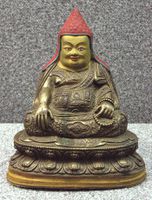Difference between revisions of "Dol po pa"
m (Text replacement - "|Images=" to "|images=") |
m (Saved using "Save and continue" button in form) |
||
| Line 30: | Line 30: | ||
|PosWheelTurn=Third Turning | |PosWheelTurn=Third Turning | ||
|PosZhenRang=Zhentong | |PosZhenRang=Zhentong | ||
| + | |PosZhenRangNotes=He was the originator of the terms: | ||
| + | "According to traditional Tibetan accounts, the revolutionary theory that the ultimate is not "empty of an own-being” (rang stong) but “empty of other” (gzhan stong) arose in Dölpopas mind during a Kālacakra retreat at | ||
| + | Jonang. Lhai Gyaltsen informs us that Dölpopas realization was connected with the Kãlacakratantra and the construction of the great stüpa in Jonang, which was consecrated in 1333. One of the first works in which | ||
| + | Dölpopa expressed his new zhentong understanding of the Buddhist doctrine was his famous Ri chos nges don rgya mtsho.m His last major work wasthe Bka bsdu bzhipa (Bka' bsdu bzhi pa'i don bstan rtsis chen po, The Great | ||
| + | Reckoning o f the Doctrine That Has the Significance of a Fourth Council), which can be seen as a final summary of Dölpopas views." [[Mathes, K.]], [[A Direct Path to the Buddha Within]], p. 75. | ||
|PosEmptyLuminNotes="He typically describes both buddha nature and the dharmakāya as being ultimately really established, everlasting, eternal, permanent, immutable (ther zug), and being beyond dependent origination. He also equates the tathāgata heart with “ālaya-wisdom” as opposed to the ālaya-consciousness." [[Brunnhölzl, K.]], [[When the Clouds Part]], p. 68. | |PosEmptyLuminNotes="He typically describes both buddha nature and the dharmakāya as being ultimately really established, everlasting, eternal, permanent, immutable (ther zug), and being beyond dependent origination. He also equates the tathāgata heart with “ālaya-wisdom” as opposed to the ālaya-consciousness." [[Brunnhölzl, K.]], [[When the Clouds Part]], p. 68. | ||
|IsInGyatsa=No | |IsInGyatsa=No | ||
}} | }} | ||
Revision as of 12:23, 7 March 2018
| Wylie | dol po pa shes rab rgyal mtshan |
|---|---|
| English Phonetics | Dolpopa Sherab Gyaltsen |
- ཤེས་རབ་རྒྱལ་མཚན་
- ཤེས་རབ་མགོན་
- རྟོན་པ་བཞི་ལྡན་
- shes rab rgyal mtshan
- shes rab mgon
- rton pa bzhi ldan
| Birth: | 1292 |
|---|---|
| Death: | 1361 |
| Place of birth: | gtsang stod mnga' ris dol po gru gsum spu mdo |
Tibetan calendar dates
| Day | |
|---|---|
| Month | |
| Gender | Male |
| Element | Water |
| Animal | Dragon |
| Rab Jyung | 5 |
- Religious Affiliation
- Jonang
- Teachers
- tshul khrims snying po · skyi ston 'jam dbyangs · skyi ston grags pa rgyal mtshan · sa skya slob dpon shes rab bzang po · gzhon nu bzang po · blo gros bstan pa · jo gdan mkhan po bsod nams grags pa · nag 'bum · jo nang chos rje yon gtan rgya mtsho
- Students
- jo nang lo tsA ba blo gros dpal · g.yag sde paN chen · bsod nams rgyal mtshan · phyogs las rnam rgyal · sa bzang ma ti paN chen blo gros rgyal mtshan · 'bri gung lo tsA ba ma Ni ka shrI · nya dbon kun dga' dpal · kun spangs chos grags dpal bzang
Other Biographical info:
- BDRC Link
- https://www.tbrc.org/#!rid=P139
- Treasury of Lives Link
- https://treasuryoflives.org/biographies/view/Dolpopa-Sherab-Gyeltsen/2670
- Treasury of Lives Excerpt
- Himalayan Art Resources Link or Other Art Resource
- https://www.himalayanart.org/search/set.cfm?setID=1595
- Wiki Pages
- Person description or short bio
Expand to see this person's philosophical positions on Buddha-nature.
| Is Buddha-nature considered definitive or provisional? | |
|---|---|
| Position: | Definitive |
| Notes: | |
| All beings have Buddha-nature | |
| Position: | Yes |
| If "Qualified", explain: | |
| Notes: | |
| Which Wheel Turning | |
| Position: | Third Turning |
| Notes: | |
| Yogācāra vs Madhyamaka | |
| Position: | |
| Notes: | |
| Zhentong vs Rangtong | |
| Position: | Zhentong |
| Notes: | He was the originator of the terms:
"According to traditional Tibetan accounts, the revolutionary theory that the ultimate is not "empty of an own-being” (rang stong) but “empty of other” (gzhan stong) arose in Dölpopas mind during a Kālacakra retreat at Jonang. Lhai Gyaltsen informs us that Dölpopas realization was connected with the Kãlacakratantra and the construction of the great stüpa in Jonang, which was consecrated in 1333. One of the first works in which Dölpopa expressed his new zhentong understanding of the Buddhist doctrine was his famous Ri chos nges don rgya mtsho.m His last major work wasthe Bka bsdu bzhipa (Bka' bsdu bzhi pa'i don bstan rtsis chen po, The Great Reckoning o f the Doctrine That Has the Significance of a Fourth Council), which can be seen as a final summary of Dölpopas views." Mathes, K., A Direct Path to the Buddha Within, p. 75. |
| Promotes how many vehicles? | |
| Position: | |
| Notes: | |
| Analytic vs Meditative Tradition | |
| Position: | |
| Notes: | |
| What is Buddha-nature? | |
| Position: | |
| Notes: | "He typically describes both buddha nature and the dharmakāya as being ultimately really established, everlasting, eternal, permanent, immutable (ther zug), and being beyond dependent origination. He also equates the tathāgata heart with “ālaya-wisdom” as opposed to the ālaya-consciousness." Brunnhölzl, K., When the Clouds Part, p. 68. |
| Svātantrika (རང་རྒྱུད་) vs Prāsaṅgika (ཐལ་འགྱུར་པ་) | |
| Position: | |
| Notes: | |
| Causal nature of the vajrapāda | |
| Position: | |
